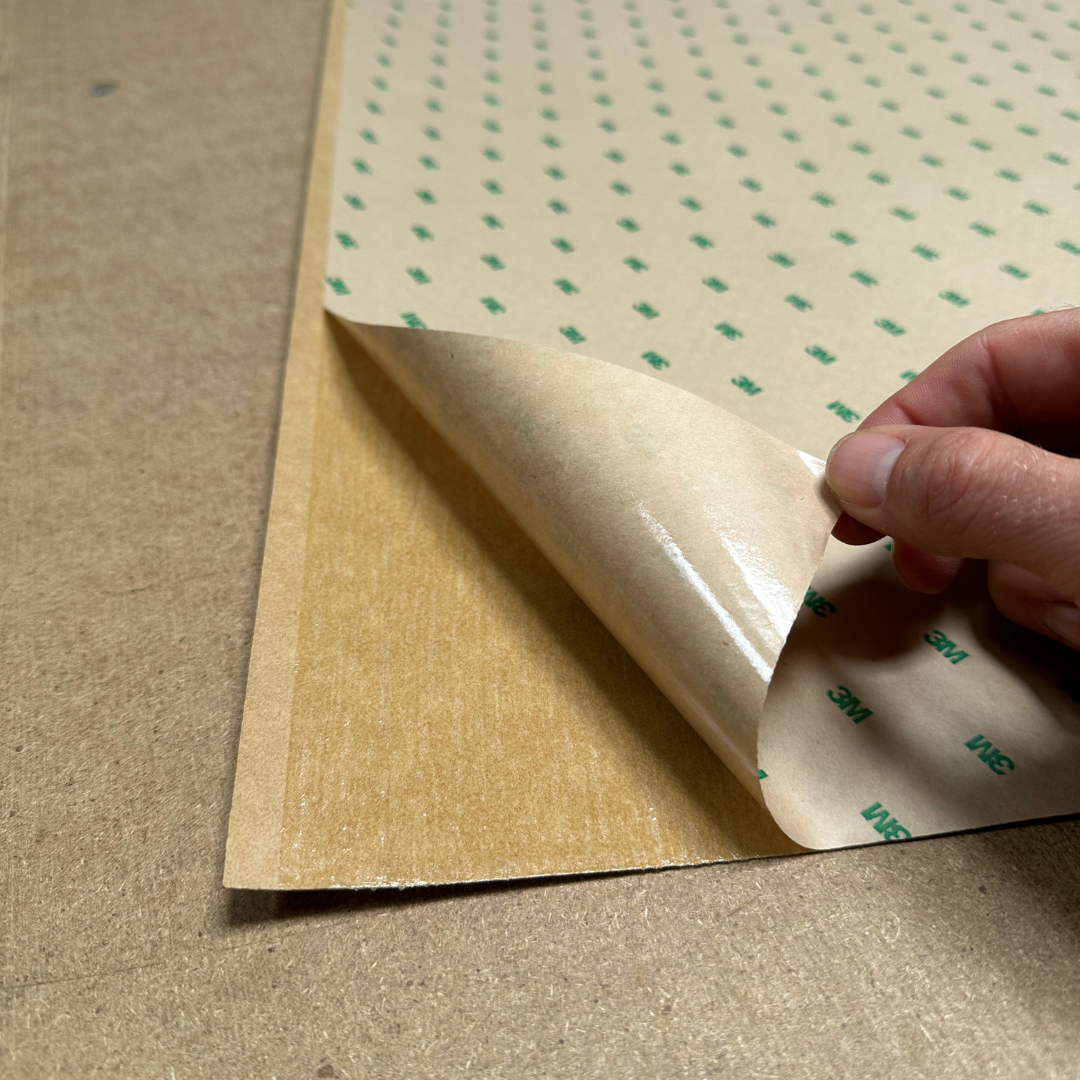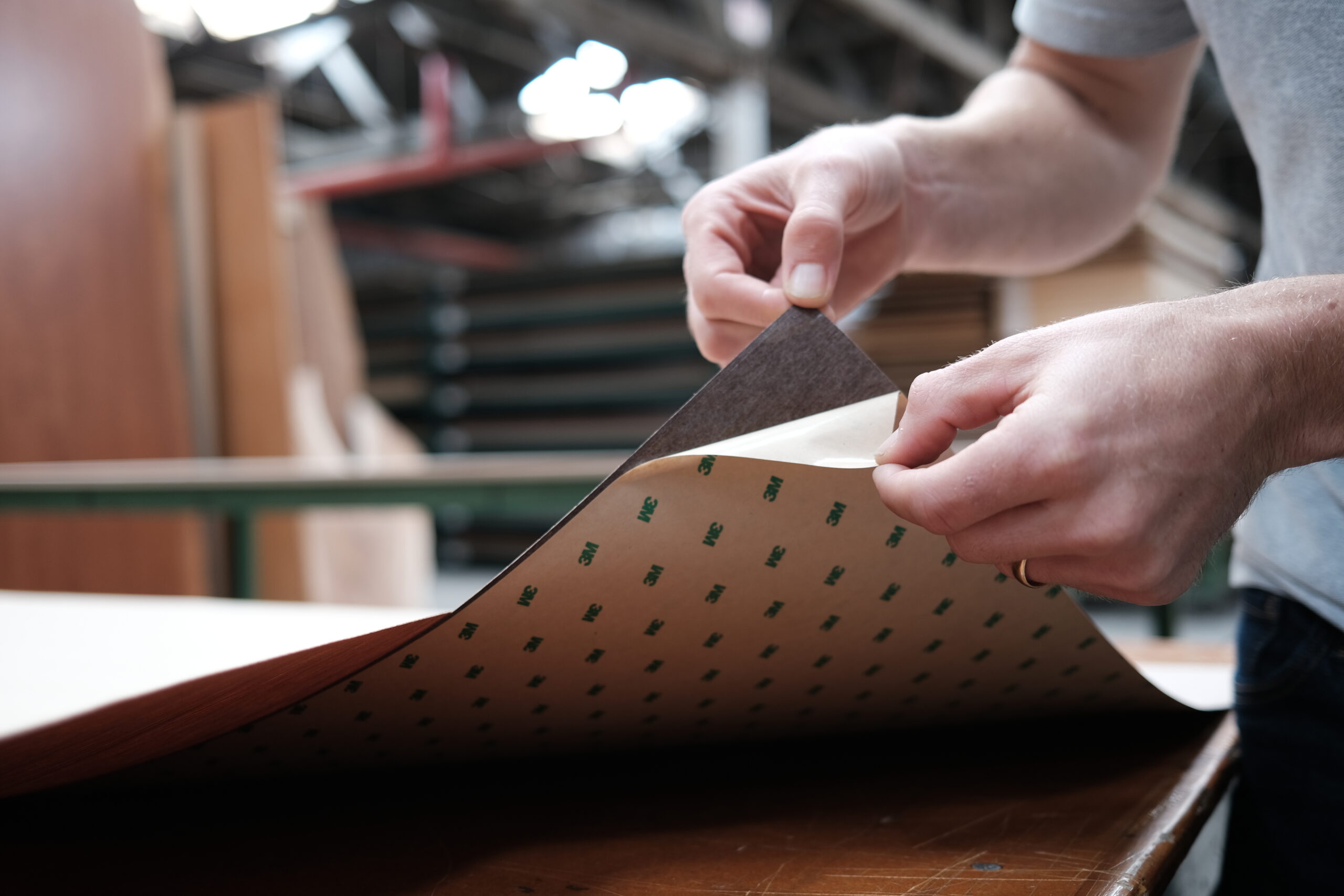A real game changer for interior designers, GL Veneer’s peel and stick wood veneer sheets can transform any room or piece of furniture into a natural work of beauty – quickly and easily – with virtually no mess and at a fraction of the cost.
For home project DIYers, peel and stick wood veneer sheets are Nirvana.
Also, known as “pressure-sensitive adhesive” or “PSA,” these sheets consist of a thin layer of real wood bonded to a paper backing that’s been pre-coated with a pressure-sensitive adhesive. You just peel off the protective backing from the adhesive side – the way you do those giant Fathead stickers – and apply your peel and stick wood veneer to the wall, furniture, or whatever surface you want to refurbish with real wood.
Now, if you’ve ever applied traditional veneer, you know how messy it can be. Kiss those days goodbye — applying peel and stick wood veneer sheets is exactly the opposite. With no gluing, no clamping, and no additional adhesives, it’s a mess-free process.
Which makes PSA ideal for quick, straightforward projects.
All you have to do is find the wood species you want. And you’ll find over 60 varieties in GL Veneer’s online gallery of Wood Veneer Sheets. Just click the “PSA” option under the “Backer” filter to instantly get a shortlist of all our available peel and stick wood veneer options.
Benefits of Using Peel and Stick Wood Veneer
Easy Application
Of all the reasons you’ll love peel and stick wood veneer, “ease of application” will surely top your list. Its pre-applied adhesive eliminates the need for messy glues and clamps. All you have to do is make sure your surface is clean, dry, and smooth. Then just peel the backing off your new wood veneer and stick it in place. Instantly, you’ll add warm, natural beauty to your interior space — using a hassle-free solution that saves you both time and effort.
Versatility & Flexibility
The real question is: What can’t you revitalize with peel and stick wood veneer? It’s so versatile, you can apply PSA to nearly any surface — wood, metal, even some plastics. Making it the perfect solution for a wide range of projects, from refurbishing old furniture to creating accent walls. Peel and stick wood veneer is literally so flexible it can be applied to flat or slightly curved surfaces, opening up a world of creative possibilities for you to add Mother Nature to virtually any design aesthetic.
Cost-Effective
While traditional wood veneer requires additional materials and tools for application, peel and stick veneer does not. It eliminates 100% of that extra cost. But that’s not the only way you save money with PSA — the reduced time and effort you spend to apply it also translates into savings. Add it all up and peel and stick veneer equals an excellent choice for both budget-conscious DIY enthusiasts and savvy professionals.
No Mess, No Fumes, No Cleanup
Reading about how to apply PSA is one thing, but watching an expert at work takes the advice to a whole new level. For a great visual reference, check out this video of Jon Peters demonstrating how to apply peel and stick wood veneer.
Best Uses for Peel and Stick Wood Veneer
DIY Home Projects
Peel and stick wood veneer is a DIYer’s dream. Here are a few ideas on how you can use it around your home:
Cabinets and Shelves: Using peel and stick wood veneer for cabinet refacing is one of the most popular uses for peel and stick veneer. It can give your kitchen or bathroom a fresh, modern look without the need for a complete overhaul.
Accent Walls: Want to create a stunning feature wall? Peel and stick veneer can transform any plain wall into a beautiful wood-paneled masterpiece. It’s an easy way to add warmth and character to your living space.
Furniture Refinishing: Old furniture pieces can be given a new lease on life with peel and stick veneer. Whether it’s a dresser, table, or bookshelf, the veneer can cover up scratches and dings, making the furniture look brand new.
Commercial Applications
Peel and stick wood veneer isn’t just for homes. It has numerous commercial applications as well:
Office Interiors: Peel and stick veneer can be used to create elegant and professional office interiors. From conference room walls to desk surfaces, it adds a touch of class without the need for extensive renovations.
Retail Spaces: In retail environments, peel and stick veneer can be used to create attractive displays and fixtures. Its ease of application means that store layouts can be updated quickly to keep up with changing trends.Hospitality Industry: Hotels and restaurants can benefit from the quick renovations that peel and stick veneer offers. It’s a cost-effective way to update the look of guest rooms, lobbies, and dining areas without disrupting business operations.
How to Apply Peel and Stick Wood Veneer
Applying peel and stick wood veneer sheets is straightforward if you follow these steps:
Surface Preparation: The key to a successful application is proper surface preparation. Make sure the surface is clean, dry, and smooth. Any dust, grease, or unevenness can prevent the veneer from adhering properly.
Cutting and Measuring Veneer: Measure the area you want to cover and cut the veneer sheets accordingly. It’s always a good idea to cut slightly larger pieces and trim them down after application to ensure a perfect fit.
Applying the Veneer: Start by peeling off a small section of the backing and align the veneer with the surface. Gradually peel off the backing while pressing the veneer down firmly with a roller or squeegee to remove any air bubbles and ensure a strong bond.
Finishing Touches and Maintenance Tips: Once the veneer is applied, trim any excess with a sharp utility knife. To keep the veneer looking its best, clean it regularly with a damp cloth and avoid using harsh chemicals or abrasive cleaners.

Common Mistakes to Avoid
Not Preparing the Surface Properly: Skipping the cleaning step can result in poor adhesion and a less durable finish. Always take the time to prepare the surface properly.
Incorrect Measurements: Measure twice, cut once. Accurate measurements are crucial to ensure a seamless application.
Skipping the Finishing Touches: Neglecting the final trimming and pressing can leave the veneer looking sloppy. Take the time to finish the edges and smooth out any bubbles.


